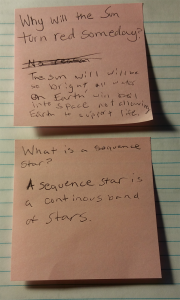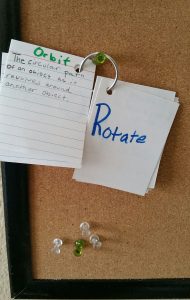5 Easy Study Strategies for Elementary Students
The biggest hurdle I had as a student was learning to realize the difference between completing homework assignments and actual studying. My parents would tell me
 to study, I would assure them I did – then midterm grades would come out. They would assume I’d done nothing, I’d insist I’d done something, and the end result would be three frustrated people as I scrambled to salvage my grades for the report card.
to study, I would assure them I did – then midterm grades would come out. They would assume I’d done nothing, I’d insist I’d done something, and the end result would be three frustrated people as I scrambled to salvage my grades for the report card.
As an adult, educator, and parent, I want to help others who may fall into that same predicament, including my son, Brandon. Brandon is close to starting middle school and I want to jump start good study habits before he leaves elementary.
I believe the most critical part of learning how to study is figuring out “what to do“. Knowing different strategies to use while studying is key to studying with success.
Here I’ll share the top 5 easiest studying strategies I am beginning to use at home with my fifth grader. Keep in mind, the strategies I use really aren’t new at all, but they are pretty helpful to recall when showing a young learner the ropes.
Study Strategy #1: Re-read Chapter or Info in Text
This can actually be a little tricky if, like my son, students aren’t allowed to bring home the text books used in class. As an alternative, I have him bring home his notebooks to read over or we find additional sources for information. In my home, this typically means using the internet. We will search from verified sites such as Britannica for Kids or Biography.com, as well as sites that accept user input, such as Wikipedia.
 Study Strategy #2: Copy Class Notes
Study Strategy #2: Copy Class Notes
A tried and true method that helped me through Biology class in college is to copy class notes into a new notebook. Studies have shown there’s a connection between writing and the ability to recall information. I believe writing the same information again reinforces the content and allows for greater grasp of understanding. This year I have my son bringing home all notebooks to rewrite his notes (in neat handwriting) on looseleaf paper we keep in a binder at home.
Study Strategy #3: Highlight Key Terms & Facts
After reading and rewriting notes, using a highlighter to mark important facts and keywords is a great way to call attention the the information. The trick I’m currently working on is teaching my son to not mark the entire page! A benefit to using this strategy is that it also reinforces finding the main idea of a passage.
Study Strategy #4: Write Questions on Sticky Tabs
 As my son reads over his notes and information (often times he reads to me while I’m cooking), I’ve instructed him to use sticky tabs to notate questions he has about the material. When he’s finished, he searches online to answer each question. I have him explain his findings to me to ensure he understands the material. I think this strategy is beneficial because it allows the student to identify gaps in his/her understanding and take ownership in researching to bridge the gaps.
As my son reads over his notes and information (often times he reads to me while I’m cooking), I’ve instructed him to use sticky tabs to notate questions he has about the material. When he’s finished, he searches online to answer each question. I have him explain his findings to me to ensure he understands the material. I think this strategy is beneficial because it allows the student to identify gaps in his/her understanding and take ownership in researching to bridge the gaps.
Study Strategy #5: Make Flash Cards
Another “oldie but goodie” is to have your young 
learner create his or her own flash cards. A stack of index cards and a couple of markers are great tools to use along the way to learning vocabulary, biographical
information, or historic events. My son writes the key term on the front of the card in marker, the answer on the back in pencil, and even gathers all his cards together using a cheap binder ring for personalized learning ready to travel! Making flash cards is a great idea for young learners because they are able to determine what information they have not fully grasped, they are rewriting the content, and it caters to three of the four main learning styles (visual, reading/writing, and kinesthetic).
